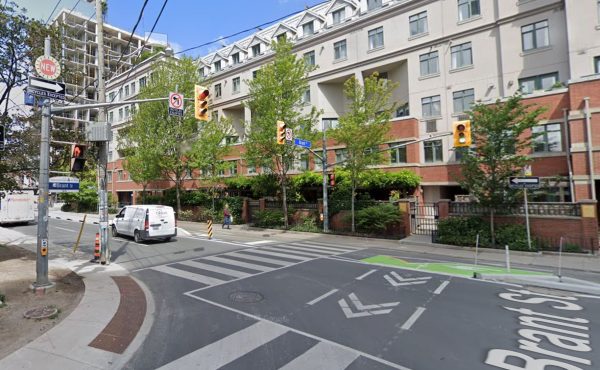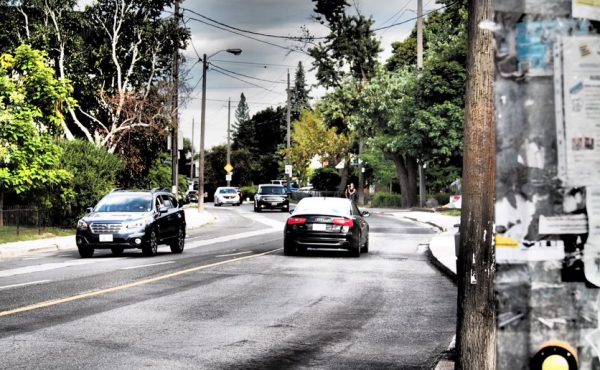![]()
Yesterday, a Canadian Press story made the media rounds noting a small spike in pedestrians hit by vehicles in Toronto, including one death on Wednesday and one seriously injured child.
As is so often the case, the police response quoted in the article focused entirely on the role of pedestrians in these collisions. Sgt. Tim Burrows is quoted as saying that the adverse weather (heavy rain and wind) may have played a factor:
“Pedestrians sometimes want to get out of the elements really quick,” he said. “They may sacrifice their own personal safety doing that, not taking that extra precaution of stopping, looking, listening – the good basic safety principles that protect us all.”
I can’t say whether this was all that Sgt. Burrows said or whether the reporter chose this focus, but it is frustrating to see. (Addendum: in a blog post on this subject also published today, Sgt. Burrows indicates that his safety messages are often left incomplete in media reports. H/t Jonathan Goldsbie).
The fact is, both drivers and pedestrians play a role in collisions, and it’s equally important for police and the media to remind drivers to drive more carefully and make more effort to watch for pedestrians when weather is bad and visibility low, as it is to remind pedestrians to be more careful. Media coverage of pedestrian safety is rare enough — it’s important to use the opportunity to get the safety message across to drivers as well as people on foot.
In fact, just last week the police conducted a pedestrian safety campaign, ticketing both drivers who endangered pedestrians, and pedestrians who engaged in risky behaviour. Not only is the press release announcing the results (PDF) commendably even-handed (“All motorists, cyclists and pedestrians are reminded that road safety is everyone’s responsibility”), but the results show that over 10,000 tickets were issued to drivers, and just over 1,000 to pedestrians. The results may be skewed (perhaps pedestrians were more often given warnings), but it nonetheless shows that driver behaviour plays a significant role in causing collisions with people on foot, and needs to be addressed as well.
The timing of the police safety campaign was well-chosen — it took place right after the end of daylight savings time, when evening rush hour is suddenly taking place in darkness. A pedestrian collisions study done by the City of Toronto a few years back showed that there was often an increase in collisions in October and November, most likely because of increasing darkness during the busy rush hour. (Regrettably, the study did not go into the depth that would have been needed to confirm this cause).
It makes a lot of sense to try to remind people that they need to be more careful at a time when we know there is increased danger, but a police enforcement campaign may not be sufficient — it did not generate a lot of publicity, and targeting individual behaviours is just a drop in the bucket. As well, the campaign was not explicit about the danger of increasing darkness, and we still ended up with a spike in collisions.
What would really make sense is a public education campaign produced by the City, with ads (maybe in bus shelters), telling both drivers and pedestrians explicitly that collisions increase as the days get shorter. A targeted campaign like that might be more memorable that the usual vague public education campaigns, and it might actually reduce the number collisions and subsequent injuries.




7 comments
I encourage you to read Sgt. Burrows’s own blog post in which he argues that his “everybody shares responsibility” message is often mangled by the media reports that quote him.
Dylan;
Thanks for taking the time to address this issue in your blog post.
I wish that there was an easy way to change the behaviour of all our road users instantly. I also wish that complete interviews could be reported so that it would never be assumed that we only address one road user group.
We really do go to great lengths to ensure that all actions are addressed each and every time from all possible views.
I will bring up your idea of a greater and more wide spread campaign the next time we have a city traffic safety meeting.
I would also like to explore the idea of teaming up with bloggers to create a digital awareness campaign through the various groups of dedicated users like yourself.
Again, thanks for raising the awareness for our shared interest of safer roads fro everyone.
Tim
Very even handed attempt to address the officer’s comments, in a way that the media doesn’t. I am not sure how the police PR department should, or can, handle the bias against pedestrians and cyclists in the media. Perhaps the police should hammer the point that though listeners may drive, their children and their aged parents are cycling or on foot.
Living in Tokyo, I did some research on traffic fatalities, and they are about half: for vehicle occupants, cyclists and pedestrians. I do not believe it is an infrastructure or cultural difference: the streets are very cluttered, and cyclists and pedestrians seem more careless than in Toronto. Neither do I find that policing is more onerous. The difference can and should be implemented in Ontario: the consequences of hitting someone in Japan are draconian.
http://forum.gaijinpot.com/showthread.php?20649-Fatal-Car-Accident.
Contrast with a similar set of pedestrian fatality announcements recently in New York, where responsibility was shared but the statements clearly focused on changing DRIVER behaviour:
http://www.nyc.gov/html/dot/html/pr2010/pr10_053.shtml
Hi Tim – thanks for your comments – I’m sure the Toronto Pedestrian Committee would be happy to team up with Police Services to push for a more comprehensive safety awareness campaign ahead of the end of Daylight Savings Time next fall. There are definitely things we can work together towards.
Dylan
While I agree that the onous should be on drivers of vehicles to be fully cognizant of those things around them and take responsibility for any lack of judgement or attention, beating someone up severely after the fact will not change the outcome. A pedestrian, irregardless of fault will still be severely injured or dead. We are all responsible for our safety in any situation. Failing to take precautions, crossing against the lights or taking risks to avoid walking a half block to a signalled intersection is truly not using common sense.
@Patrick, you are forgetting about the deterrent effect of treating collisions more seriously. I do not suggest we need to sue people into bankruptcy, nor put all drivers in jail who have been in an accident. The status-quo in Ontario where drivers can kill while on a suspended licence, or after having been caught for drunk driving, and continue to drive, is offensive. At the very least these people should be in jail, and never be allowed to drive again:
– repeat drunk or suspended-licence offenders
– drivers who leave the scene (Michael Bryant)
The following should have their licence pulled for a couple of years:
– first time drunk drivers
– grossly reckless drivers
– those with repeat speeding tickets, failure to signal, etc.
This can be implemented in short order, sold to the majority of the driving public as a way to keep them safe, and their children and aged parents. The failure of political will, in the public and the politicians, eaves me in despair of the Ontario population.